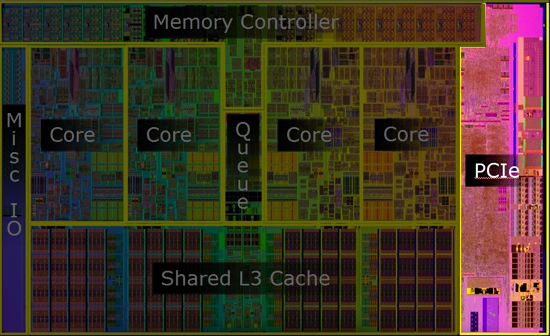Intel's Core i7 870 & i5 750, Lynnfield: Harder, Better, Faster Stronger
by Anand Lal Shimpi on September 8, 2009 12:00 AM EST- Posted in
- CPUs
Overclocking Lynnfield at Stock Voltage: We're PCIe Limited
Remember the on-die PCIe controller? Yep. It's to blame.
Lynnfield is Intel's first attempt at an on-die PCIe controller and it actually works surprisingly well. There are no performance or compatibility issues.

The on-die PCIe controller needs more voltage as you overclock Lynnfield, limiting Lynnfield's stock vt overclocking potential.
Unfortunately the PCIe controller on Lynnfield is tied to the BCLK. Increase the BCLK to overclock your CPU and you're also increasing the PCIe controller frequency. This doesn't play well with most PCIe cards, so the first rule of thumb is to try and stay at 133MHz multiples when increasing your BCLK.
The second issue is the bigger one. As you increase the BCLK you increase the frequency of the transistors that communicate to the GPU(s) on the PCIe bus. Those transistors have to send data very far (relatively speaking) and very quickly. When you overclock, you're asking even more of them.
We know that Bloomfield can easily hit higher frequencies without increasing the core voltage, so there's no reason to assume that Lynnfield's core cannot (in fact, we know it can). The issue is the PCIe controller; at higher frequencies those "outside facing" transistors need more juice to operate. Unfortunately on Lynnfield rev 1 there doesn't appear to be a way to selectively give the PCIe transistors more voltage, instead you have to up the voltage to the entire processor.
Intel knows the solution to Lynnfield's voltage requirement for overclocking, unfortunately it's not something that can be applied retroactively. Intel could decouple the PCIe controller from BCLK by introducing more PLLs into the chip or, alternatively, tweak the transistors used for the PCIe interface. Either way we can expect this to change in some later rev of the processor. Whether that means we'll see it in the 45nm generation or we'll have to wait until 32nm remains to be seen.
The good news is that Lynnfield can still overclock well. The bad news is that unlike Bloomfield (and Phenom II) you can't just leave the Vcore untouched to get serious increases in frequency.










343 Comments
View All Comments
HexiumVII - Tuesday, September 8, 2009 - link
I must say that Lynnfield is the best stock processor ever. It will o/c itself without you having to touch it at all. Nearly perfect for the masses. I absolutely can't wait for the notebook incarnation.ClagMaster - Tuesday, September 8, 2009 - link
The performance of these processors is what I thought they would be based on your May Preview Article. Its great the NDA is lifted and we can now see what this processor can really do.This is hardly a Celeron. I know a troll in earlier Lynnfield/P55 that should be eating crow.
Apahutec - Tuesday, September 8, 2009 - link
Not sure what "core parking" priorities are (reduce power consumption by grouping tasks on active CPUs, or tune performance by taking into account cache trashing in scheduler decisions), but it sounds like it could even be beneficial on my Core 2 Quad: single socket, no HT, but two Core2 Duo (each with its own L2 cache) glued together.erple2 - Tuesday, September 8, 2009 - link
Sounds like it, but the logic that controls that on the CPU is on the CPU, and uses up a couple million transistors. That would require a re-spin of the Core 2 parts (which, given the P55 platform release, I think is a safe bet won't happen), however.Obsy - Tuesday, September 8, 2009 - link
I don't get how Turbo Boost ends "dual-core or quad-core?" I know that an on-die IGP is a selling point for the upcoming 32nm dual cores, but wouldn't they be clocked higher than these quads and have Turbo Boost too? There will be dual cores clocked higher than quads again. Or is Intel not clocking their dual cores past the speeds of quads?macs - Tuesday, September 8, 2009 - link
Would be interesting an article about P55 mobo with nf200 chip and 2 gpu...Ryan Smith - Tuesday, September 8, 2009 - link
We talked to NVIDIA about that scenario a couple of weeks ago. A NF200 chip would not make a significant difference in performance, which is why they're letting manufacturers go ahead and just split lanes with a straight-up bridge chip.Darkanyons - Tuesday, September 8, 2009 - link
Thanks for this great article!!Tomzi - Tuesday, September 8, 2009 - link
Do the PCIe controller's voltage demands impose stricter limits on undervolting in the case of Lynnfield processors compared to Bloomfield? I can run my i7 920 at stock frequncies undervolted to 0.9xx V VCore. How much voltage (power consumption) reduction can we expect from the an i5 750?This might not be a hot topic so close to the release of the new chips when everyone is focused on top performance comparisons but I've always been interested in undervolting/clocking and would like to see a more complete picture.
Tomzi - Tuesday, September 8, 2009 - link
750 and 870 undervolted by ~0.1V reported on silentpcreview.